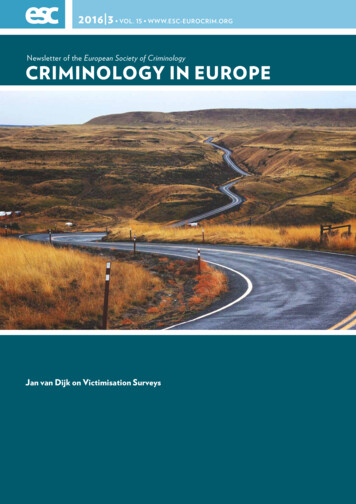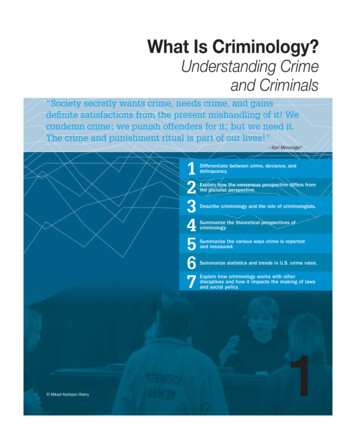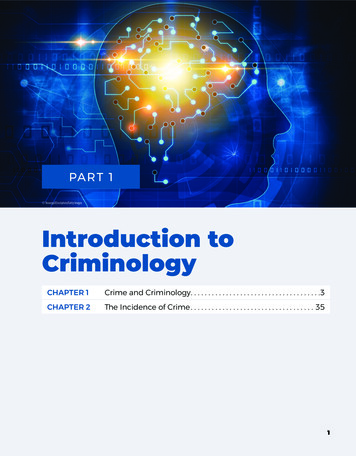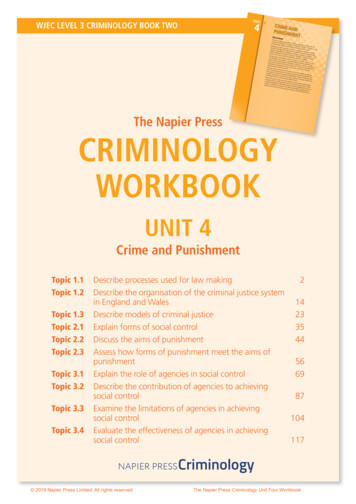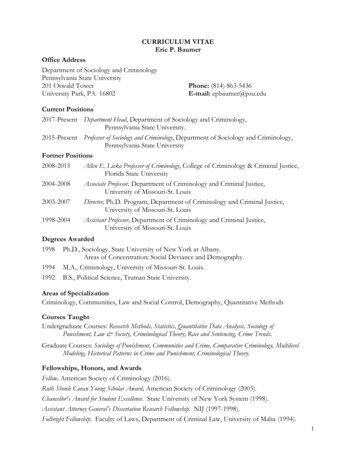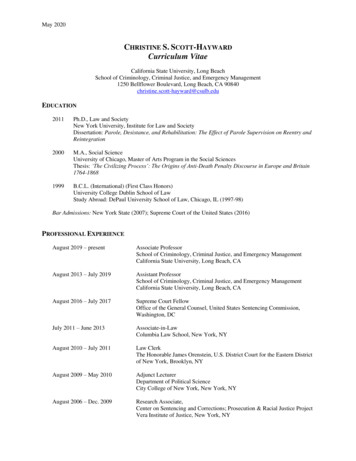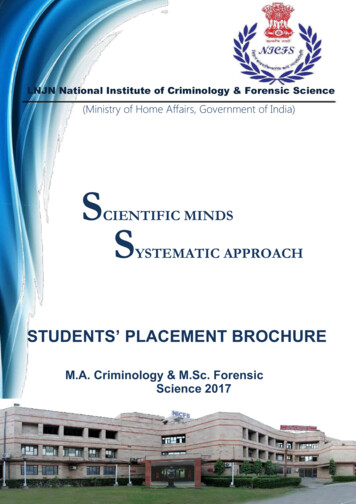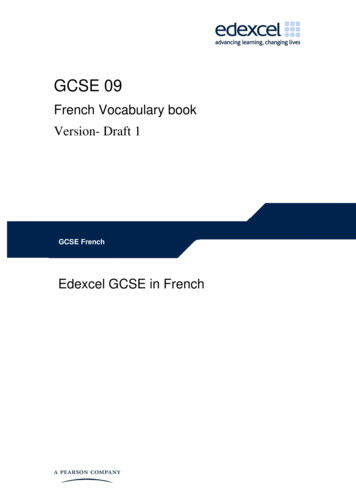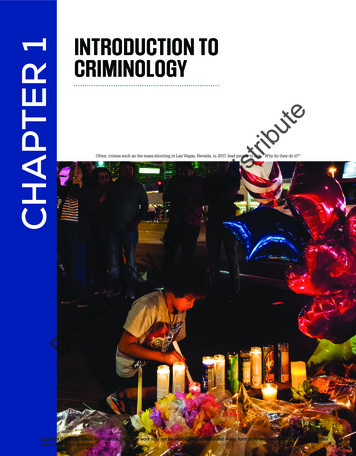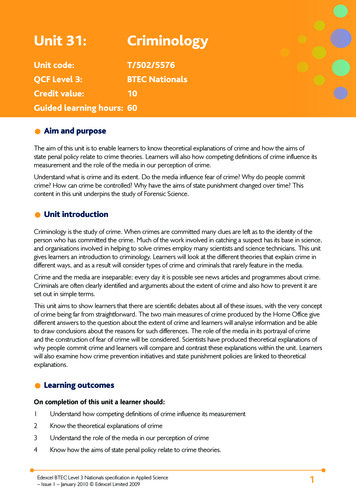
Transcription
Unit 31:CriminologyUnit code:T/502/5576QCF Level 3:BTEC NationalsCredit value:10Guided learning hours: 60Aim and purposeThe aim of this unit is to enable learners to know theoretical explanations of crime and how the aims ofstate penal policy relate to crime theories. Learners will also how competing definitions of crime influence itsmeasurement and the role of the media in our perception of crime.Understand what is crime and its extent. Do the media influence fear of crime? Why do people commitcrime? How can crime be controlled? Why have the aims of state punishment changed over time? Thiscontent in this unit underpins the study of Forensic Science.Unit introductionCriminology is the study of crime. When crimes are committed many clues are left as to the identity of theperson who has committed the crime. Much of the work involved in catching a suspect has its base in science,and organisations involved in helping to solve crimes employ many scientists and science technicians. This unitgives learners an introduction to criminology. Learners will look at the different theories that explain crime indifferent ways, and as a result will consider types of crime and criminals that rarely feature in the media.Crime and the media are inseparable; every day it is possible see news articles and programmes about crime.Criminals are often clearly identified and arguments about the extent of crime and also how to prevent it areset out in simple terms.This unit aims to show learners that there are scientific debates about all of these issues, with the very conceptof crime being far from straightforward. The two main measures of crime produced by the Home Office givedifferent answers to the question about the extent of crime and learners will analyse information and be ableto draw conclusions about the reasons for such differences. The role of the media in its portrayal of crimeand the construction of fear of crime will be considered. Scientists have produced theoretical explanations ofwhy people commit crime and learners will compare and contrast these explanations within the unit. Learnerswill also examine how crime prevention initiatives and state punishment policies are linked to theoreticalexplanations.Learning outcomesOn completion of this unit a learner should:1Understand how competing definitions of crime influence its measurement2Know the theoretical explanations of crime3Understand the role of the media in our perception of crime4Know how the aims of state penal policy relate to crime theories.Edexcel BTEC Level 3 Nationals specification in Applied Science– Issue 1 – January 2010 Edexcel Limited 20091
Unit content1 Understand how competing definitions of crime influence its measurementDefinitions of crime: legal; normativeMeasurement of crime: Home Office official statistics; police discretion; reported and recorded crime;British Crime Survey data; self reporting of crime; hidden crime; discrepancy between the two measures;quantitative and qualitative evidence2 Know the theoretical explanations of crimeCriminological explanations of crime: positivist criminology, eg individual positivism (genetic andpsychological explanations); emergence of realist explanations, eg left and right realism; influence ofinteractionism and labelling theories; conflict between determinism and voluntarismCrime prevention measures aimed at individual: zero tolerance; CCTV; ASBOsCrime prevention measures aimed at the community: ‘Broken windows’ theory, neighbourhood watch3 Understand the role of the media in our perception of crimeMedia: Cohen’s moral panic explanation; media campaigns; labellingInfluence on crime figures and fear of crime: research on fear of crime against risk of crime; media sourcesof information4 Know how the aims of state penal policy relate to crime theoriesReview of penal policy: from early twentieth century deterrence to rehabilitation then reform andrestorative justice; voluntarism; determinism; realism and linkage to theoretical perspectives2Edexcel BTEC Level 3 Nationals specification in Applied Science– Issue 1 – January 2010 Edexcel Limited 2009
Assessment and grading criteriaIn order to pass this unit, the evidence that the learner presents for assessment needs to demonstrate thatthey can meet all the learning outcomes for the unit. The assessment criteria for a pass grade describe thelevel of achievement required to pass this unit.Assessment and grading criteriaTo achieve a pass grade theevidence must show that thelearner is able to:To achieve a merit grade theevidence must show that, inaddition to the pass criteria,the learner is able to:P1describe competingdefinitions of crime[IE1,2]M1 draw conclusions from theirD1analysis with consideration ofhow the figures are producedexplain how the differencein crime figures relate to thereported/recorded crimefigures and the definition ofcrime used by the agencyP2analyse the crime figuresproduced by Home Officeofficial statistics and the BritishCrime Survey[IE4]P3describe theoreticalexplanations of crime[IE1,2]M2 explain the ways in which the D2theoretical explanations haveinfluenced current politicalpolicies on crime controlexplain the challenge ofrealism which replacedpositivism as the majorcriminological theory in thelate 20th centuryP4identify the influences thatthe theoretical explanationsof crime have had on currentcrime control policies[SM7; EP4,5,6]P5describe how the mediainfluence our understandingof crime[CT2,3; RL2]M3 report on factors whichinfluence fear of crimeD3outline the theoreticalexplanation of moral panicsdeveloped by S. Cohen anduse it to illustrate a currentcrime problemP6explain the differencebetween the fear of crimeand the actual risk of crime[CT2,3,4; RL2]P7outline ways in whichcriminological theoryinfluenced penal policy overthe last century.[EP4,5,6]M4 explain how crime theorieshave influenced penal policy.D4analyse the influence ofpositivism and realism onpenal policy over the lastcentury.Edexcel BTEC Level 3 Nationals specification in Applied Science– Issue 1 – January 2010 Edexcel Limited 2009To achieve a distinction gradethe evidence must show that,in addition to the pass andmerit criteria, the learner isable to:3
PLTS: This summary references where applicable, in the square brackets, the elements of the personal,learning and thinking skills applicable in the pass criteria. It identifies opportunities for learners to demonstrateeffective application of the referenced elements of the skills.Key4IE – independent enquirersRL – reflective learnersSM – self-managersCT – creative thinkersTW – team workersEP – effective participatorsEdexcel BTEC Level 3 Nationals specification in Applied Science– Issue 1 – January 2010 Edexcel Limited 2009
Essential guidance for tutorsDeliveryTutors delivering this unit have the opportunity to use a wide range of techniques, not only to providetheoretical input but also to allow learners to collect and use both quantitative and qualitative data.Formal lectures, group discussions, presentations, site visits, practical compilation of self-reported crimemeasurements using either simulated data or data from websites, practical use of recorded crime data fromHome Office websites, input from community police officers, and research using library resources, internet,newspapers and/or television would all be suitable.The subject of this unit is always in the news. In their daily lives, learners will see evidence of crime controlstrategies such as CCTV cameras and media reports on the use of ASBOs. Many television programmes alsohighlight crime: either actual crime (eg Crimewatch) or fictional crime (eg The Bill). Therefore the deliveryof this unit should not only educate learners (by making them aware of the fear and fascination of crime) butalso motivate them and encourage a critical approach to the populist and common sense views of crime and‘criminals’.To cover learning outcome 1 learners will need to understand that the fundamental concept of crime is itselfcontested and that different definitions of crime are used by the state in measuring crime. The legal definitionis used by the agencies of the Criminal Justice System (CJS) and this has implications in how official HomeOffice statistics are produced. The other main measure of crime used by the Home Office is the BritishCrime Survey. Learners will need to work with the statistics from both sources and draw out differencesbetween the two to show the influence of different types of evidence. Debates and presentations wouldbe appropriate to address this area but input from a police community officer on how the police measurecrime would be a very valuable input. Knowledge gained in this learning outcome informs learners in theirconsideration of learning outcome 4.For learning outcome 2 the theoretical positions of positivism, realism and interactionism need to beaddressed and it is important that learners get the opportunity to not only consider the contested natureof the positions but also that there are linkages between theory and policy. This could lead to learnersundertaking practical tasks to research crime control in their local community. Consideration of factors whichled to the replacement of the dominant scientific positivist theory by realism should introduce learners to theway in which theory and politics interact.In learning outcome 3 learners should have the opportunity to engage in practical exercises to research theirlocal communities for evidence of media coverage of crime. Topical media campaigns against crimes are veryrelevant to this learning outcome and should be used to stimulate debates on fear of crime and risk from it.Ideally a visit to a local newspaper or other media organisations and an opportunity to talk to crime reporter/swould be extremely useful. Here, input from local magistrates to talk about initiatives such as ASBO’s wouldbe very relevant.For learning outcome 4 the knowledge gained in the first learning outcome gives learners a base on whichto relate policy changes over time to the influence of criminological theories. Here too political influencesare relevant in the aims and operation of the criminal justice system. Debates by learners on the purposeof imprisonment would be very useful in drawing out different aims of that state sanction. Input from justicesystem agencies would be useful here to put the discussions into context.Edexcel BTEC Level 3 Nationals specification in Applied Science– Issue 1 – January 2010 Edexcel Limited 20095
Outline learning planThe outline learning plan has been included in this unit as guidance and can be used in conjunction with theprogramme of suggested assignments.The outline learning plan demonstrates one way in planning the delivery and assessment of this unit.Topic and suggested assignments/activities and/assessmentUnit introduction and outline of programme of assignments.Tutor input: Outline the key questions in the unit and how they will be covered.Group based discussion: what does crime mean to learners; opportunity to differentiate between legally-definedand against normative crimes.Tutor input: competing definitions of crime linked back to learner experiences.Teaching and research session on types of crime which feature regularly in the media/press, how are theyreported, who are the typical criminals.Follow up on hidden crime: why are some types of crime not covered, white collar/corporate crime.Tutor input: how Home Office official statistics are compiled, type of evidence, police methodology reported/recorded crime, discretion.Practical exercise: visit to police station or talk by community liaison officer on how crime figures are collected.Use examples of reported/recorded crime.Group activity: Home Office and British Crime Survey statistics.Evidence collection by groups on the level of crime measured by these two methods for the same time period,eg 1998 figures show discrepancy of around 400%.Assignment 1 – How Much Crime Exists in the UK? (P1, P2, M1, D1)Tutor input: theories of crime; looking at developments over time.Case study activities: using current news items to look at assumptions about human behaviour. The scientificbase of positivism and its dominance in much of twentieth century with examples from genetic and psychologicaltheories to provide base for linkage to policy.Tutor input and discussion: challenges to positivism – interactionism and labelling theory then activities aroundlabelling of young people.Tutor input: rise of right realism, link to political changes in UK (and USA) how did this influence crime controlpolicies?Group exercises: situational crime control; discussions about ASBOs and their impact on individuals. Police inputon ASBO’s would be relevant here.Tutor input and group discussion: alternative left realist theory link to politics and crime control policies; socialcrime control.Practical activities and information gathering.Assignment 2 – The Rise of CCTV (P3, P4, M2, D2)6Edexcel BTEC Level 3 Nationals specification in Applied Science– Issue 1 – January 2010 Edexcel Limited 2009
Topic and suggested assignments/activities and/assessmentTutor input: types of media used to report on crime in UK.Group activities: research portrayal of crime, nationally and in the local area, collection of evidence,presentations.Tutor input: describe the moral panic theory of S. Cohen.Group activities: research moral panics; impact on people in local community and/or school/college. Learnerscould conduct surveys.Tutor input: research about fear of crime and risk of crime.Practical activities and information gathering.Assignment 3 – Media Portrayal of Crime (P5, P6, M3, D3)Research activity: collect evidence about penal policy from early twentieth century through to current dayinitiatives.Tutor input: policy of deterrence and its linkage to theory.Tutor input: rise of rehabilitation and link to positivism.Tutor input: challenges to rehabilitation and rise of reform, linkage to realism; current initiatives includingreformative justice. Use input from justice system agencies if possible.Practical activities and information gathering.Assignment 4 – Penal Policy (P7, M4, D4)Unit review and programme of assignments.AssessmentThe unit can be assessed by a variety of strategies which include essays, reports, presentations, posters andrecords of debates. All of the Pass grade criteria must be met for a learner to achieve this unit.For P1, learners must be able to describe competing legal and normative (social constructionist) definitions ofcrime. Group discussions on what learners see as crime would provide evidence which could illustrate legaland normative crime. Historical evidence could also be used, for example in USA alcohol consumption waslegal, it became a crime in Prohibition era then became legal again. For P2, learners need to analyse givencrime data from the official Home Office statistics of recorded crime as well as reported crime data fromBritish Crime Survey for the same year. For M1, learners must be able to relate the differences betweenthe main measures of crime shown for P2 to their measurement. This involves identification of the types ofevidence used to prepare both Home Office official statistics and British Crime Survey data. Here quantitativeand qualitative data must be recognised as being fundamentally different and what they entail. To meet D2criterion learners must move on from identification of the differences between the two main measures ofcrime to specifically link legal definition and recording of crime to Home Office statistics (crucially not all crimesreported to the police are then recorded by them). This must be contrasted with BCS use of normativecrime definition and use of self reporting of crime.For P3, learners must describe positivist, realist and interactionist explanations of crime, taking note of contentguidance. For P4, from the theoretical explanations of crime learners must select those which influence crimecontrol policies, again taking note of content guidance (realist theory is dominant here). For M2, learnersneed to look at the ways in which theoretical explanations of crime have influenced political policies on crimecontrol, because changes in dominant criminological theories have a real impact on the practices of thecriminal justice system. D2 achievers need to show an appreciation of factors which led to the replacementof positivism as the dominant criminological theory by right realism. These may include financial as well aspolitical aspects.Edexcel BTEC Level 3 Nationals specification in Applied Science– Issue 1 – January 2010 Edexcel Limited 20097
For P5, learner must describe how the media influence our knowledge and understanding of crime. Evidencefrom local and national media campaigns would underpin this criterion. For P6, learners must be able toexplain the difference between fear of crime and risk from it, taking into account various influencing factors.For M3, learners need to build on the basic information collected for P6 and move on to research factorswhich contribute to fear of crime. This needs to take account of the content guidance. For D3, the importantexplanation of moral panics is extremely relevant for learners to understand arguments about the role of themedia in our perception of crime. Application of the Cohen argument to a recent moral panic is required toshow the application of theory to current problems.For P7, learners must be able to review penal policy and relate changes to crime theories with particularfocus on the move from positivist to realist theory. For M4, learners need to consider the aims of the criminaljustice system in relation to penal policy over time and draw links to criminological and political influences.For D4, learners need to be able to relate positivist and realist theories to penal policies used by the UK inthe last century. The change from rehabilitation to reform must be specifically linked to key arguments aboutvoluntarism and determinism (if crime is determined then offenders cannot be punished – positivism; if crimeis voluntary then punishment is valid – realism).Programme of suggested assignmentsThe table below shows a programme of suggested assignments that cover the pass, merit and distinctioncriteria in the assessment and grading grid. This is for guidance and it is recommended that centres eitherwrite their own assignments or adapt any Edexcel assignments to meet local needs and resources.Criteria coveredAssignment titleScenarioAssessment methodP1, P2, M1, D1How Much CrimeExists in the UK?As a junior reporter on yourlocal newspaper you wantto investigate the concept ofcrime and how crime statisticsare gathered.Report/article.P3, P4, M2, D2The Rise of CCTVYou are a teacher in a localcollege. Your learners haveseen a lot of CCTV systemsin their local area and ask whythat is the case. You need toplan a lesson to explain (this isone method of crime controlwhich gained popularity inthe 1970s) and stimulate classdebate.Presentation and notes.P5, P6, M3, D3Media Portrayal ofCrimeYou are on a visit to yourEssay/presentation withlocal newspaper and havedetailed notes.an opportunity to talk to thecrime reporter. How does s/heget information about crime,how would it be reported?Does crime coverage have anyinfluence on sales? Research,local surveys, questionnairesto gain information of localfear of crime covering differentage/ethnic groups.8Edexcel BTEC Level 3 Nationals specification in Applied Science– Issue 1 – January 2010 Edexcel Limited 2009
Criteria coveredAssignment titleScenarioAssessment methodP7, M4, D4Penal PolicyOn a class visit to your localRecord of debate, essay/prison, it was pointed outpresentation with notes andthat the aims of the prisonquestion/answer session.service had changed fromrehabilitation to reform.Learners are asked to researchon changes in the 1960s andto enquire why that happened.Links to National Occupational Standards, other BTEC units, other BTECqualifications and other relevant units and qualificationsThis unit forms part of the BTEC Applied Science sector suite. This unit has particular links with:Level 3Criminal PsychologyCriminal Investigation ProceduresCriminal Investigations in PracticeEssential resourcesThe unit requires learners to have access to a library or learning resource centre, books and journals oncrime, newspapers including tabloids, and the internet (eg to government statistical data Home Office andBritish Crime Survey).Employer engagement and vocational contextsThis unit would be greatly enhanced by group visits to local newspapers/media organisations, police stationsetc. Alternatively, guest speakers from these employers could be arranged.Edexcel BTEC Level 3 Nationals specification in Applied Science– Issue 1 – January 2010 Edexcel Limited 20099
Indicative reading for learnersTextbooksBecker H S – Outsiders: Studies in Sociology of Deviance (Simon & Schuster Ltd, 1997) ISBN 9780684836355Kelling L and Coles C M – Fixing Broken Windows: Restoring Order and Reducing Crime in Our Communities(Simon and Schuster Inc, 1998) ISBN 9780684837383Maguire et al – The Oxford Handbook of Criminology (Oxford University Press, 2007) ISBN 9780199205431Matthews R and Young J – Rethinking Criminology: The Realist Debate (Sage Contemporary Criminology Series)(Sage Publications Ltd, 1992) ISBN 9780803986213Mirrlees-Black C et al – The 1998 British Crime Survey: England and Wales (Home Office, 1998)ISBN 9781840821833Muncie J and McLaughlin E (editors) – The Problem of Crime (Sage Publications Ltd, 2001)ISBN 9780761969716Office for National Statistics – Social Trends (Palgrave Macmillan, 2008) ISBN 9780230545649Wilson J Q and Herrnstein R J – Crime Human Nature: The Definitive Study of the Causes of Crime(Free Press, 1998) ISBN 9780684852669JournalsBritish Journal of CriminologyBritish Society of CriminologyCivil Liberties ReviewHome Office Statistical BulletinWebsiteswww.bjc.oxfordjournals.orgThe British Journal of Criminologywww.brokenwindows.com/windows theory.htmlBroken Windows Theorywww.civitas.org.ukThe Institute for the Study of Civil Societywww.crimestatistics.org.ukCrime Statistics for England and cal Theory (Florida State University)www.homeoffice.gov.ukThe Home Officewww.homeoffice.gov.uk/rds/bcs1.htmlThe British Crime Survey10Edexcel BTEC Level 3 Nationals specification in Applied Science– Issue 1 – January 2010 Edexcel Limited 2009
Delivery of personal, learning and thinking skillsThe table below identifies the opportunities for personal, learning and thinking skills (PLTS) that have beenincluded within the pass assessment criteria of this unit.SkillWhen learners are Independent enquirers[IE1,2] researching for information on competing definitions and theoreticalexplanations for crime[IE4] analysing crime figuresCreative thinkers[CT2,3,4] investigating media portrayal of crime; discussing the differencebetween fear of crime and risk from itReflective learners[RL2] setting goals for work involving surveys about media portrayalSelf-managers[SM7] managing emotions when discussing crime control policiesEffective participators[EP4,5,6] engaging with issues when presenting information to peers.Although PLTS are identified within this unit as an inherent part of the assessment criteria, there are furtheropportunities to develop a range of PLTS through various approaches to teaching and learning.SkillWhen learners are Independent enquirers[IE6] drawing conclusions from analysis of crime statistics[IE3] exploring issues and events from other perspectivesCreative thinkers[CT2,4] asking questions of their own and others assumptions when interactingwith guest speakersReflective learners[RL1,5] assessing performance in group work[RL6] communicating learning in various ways to meet assessment criteriaTeam workers[TW1,6] work together on activities; providing constructive feedback to peers onpresentationsSelf-managers[SM3,5] organising and planning assignments to fit in with other commitmentsEffective participators[EP1,4] reflecting on information gathered about theories, policies and crime.Edexcel BTEC Level 3 Nationals specification in Applied Science– Issue 1 – January 2010 Edexcel Limited 200911
Functional Skills – Level 2SkillWhen learners are ICT – Use ICT systemsSelect, interact with and use ICT systemsindependently for a complex task to meet avariety of needscollecting and processing dataUse ICT to effectively plan work andevaluate the effectiveness of the ICT systemthey have usedplanning surveys and assignmentsManage information storage to enableefficient retrievalsaving and restoring information held on assignments, surveys orpresentationsFollow and understand the need for safetyand security practicescarrying out work on computers safelyICT – Find and select informationSelect and use a variety of sources ofgathering information from a variety of sources to addressinformation independently for a complex task assessment criteriaAccess, search for, select and use ICTbased information and evaluate its fitness forpurposefinding and retrieving information for assignmentsICT – Develop, present andcommunicate informationEnter, develop and format informationindependently to suit its meaning andpurpose including: text and tables images numbers recordsentering survey data and results to develop presentation materialBring together information to suit contentand purposeresearching information on crime statisticsPresent information in ways that are fit forpurpose and audiencepresenting survey results, group findings, presentationsSelect and use ICT to communicate andexchange information safely, responsibly andeffectively including storage of messages andcontact listscollecting and retrieving evidence for portfolioMathematicsUnderstand routine and non-routineproblems in a wide range of familiar andunfamiliar contexts and situationsSelect and apply a range of skills to findsolutions12analysing statistical data from the Home Office and British CrimeSurveyselecting and applying the skills needed to analyse statisticsEdexcel BTEC Level 3 Nationals specification in Applied Science– Issue 1 – January 2010 Edexcel Limited 2009
SkillEnglishSpeaking and listening – make a range ofcontributions to discussions and makeeffective presentations in a wide range ofcontextsReading – compare, select, read andunderstand texts and use them to gatherinformation, ideas, arguments and opinionsWriting – write documents, includingextended writing pieces, communicatinginformation, ideas and opinions, effectivelyand persuasivelyWhen learners are listening to teachers or guest speakers; working in groups, givingand listening to presentations; carrying out local surveysresearching information, analysing theories and policiesreporting and writing assignments, preparing notes forpresentations, preparing questions for guest speakers.Edexcel BTEC Level 3 Nationals specification in Applied Science– Issue 1 – January 2010 Edexcel Limited 200913
The aim of this unit is to enable learners to know theoretical explanations of crime and how the aims of state penal policy relate to crime theories. Learners will also how competing definitions of crime influence its . psychological explanations); emergence of realist explanations, eg left and right realism; influence of

